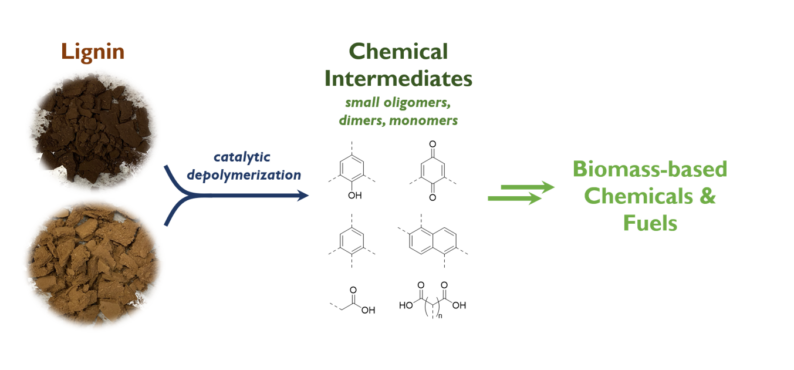The efficient utilization of lignin, the primary renewable source of aromatics, into value added chemicals is a critical step toward sustainable biorefineries. However, due to lignin’s random heterogeneous structure and limited solubility, its use has largely been restricted to combustion for energy. Catalytic depolymerization has emerged as a promising route, yet major challenges remain: low yields, poor product selectivity, high char formation, limited bioavailability of intermediates and products, and little to no recycling of transition metal catalysts.
The CLD team addresses these challenges by:
a) designing and developing robust catalysts,
b) elucidating lignin depolymerization mechanisms at catalytic sites to achieve controlled product profiles,
c) applying computational tools to decode lignin chemistry, and
d) tuning and separating bioavailable molecules derived from lignin depolymerization.
Projects
- Development of robust reductive and oxidative catalytic pathways for efficient lignin depolymerization
- Develop abiotic routes to depolymerize lignin present in bioenergy crops into targeted bioavailable intermediates with at least 90% yields
- Implementation of chemical-biological hybrid depolymerization process for maximum carbon utilization
- Development of integrated catalytic depolymerization and separation of monomeric lignin molecules
- Understanding of structure-activity relationships between catalytically active sites and lignin depolymerization activity through advanced characterization
- Understanding of lignin depolymerization routes with computational tools
- Generation of high-quality polymeric lignin and their thorough characterization
- Implementation of catalytic methods including product analysis to assist other JBEI divisions including LEAD, Feedstocks, Deconstruction, and Biofuels and Bioproducts
Recent Publications
- Distillable amine-based solvents for effective pretreatment of multiple biomass feedstocks Biofuel Research Journal, 2025, 47, 2487
- Cost of deconstruction depots for diversified, waste-based lignocellulosic sugars using distillable solvents ACS Sustainable Chemistry & Engineering, 2025, 13, 13100
- Life cycle assessment of chemical recycling of polyethylene terephthalate to produce aramid polymers ACS Sustainable Chemistry & Engineering, 2025, 13, 11733
- Chelator-mediated Fenton post-treatment enhances methane yield from lignocellulosic residues via microbial community modulation Biotechnology for Biofuels and Bioproducts, 2025, 18, 73
- The importance of ester cleavage in the butylamine pretreatment of hybrid poplar Green Chemistry, 2025, 27, 10117
- Fast growth and high-titer bioproduction from renewable formate via a metal-dependent formate dehydrogenase in Escherichia coli Nature Communications, 2025, 16, 5908
- Recent advances in the use of Ionic Liquids and Deep Eutectic Solvents for lignocellulosic biorefineries and biobased chemical and material production Chemical Reviews, 2025, 125, 5461
- Enzymatic cleavage of model lignin dimers depends on pH, enzyme, and bond type Scientific Reports, 2025, 15, 10296
- Multi-scale computational screening and mechanistic insights of cyclic amines as solvents for improved lignocellulosic biomass processing Green Chemistry, 2025, 27, 5482
- Deconstructing poplar lignin from ionic liquid pretreatment for biological conversion through sulfonation and Fenton chemistry RSC Sustainability, 2025, 3, 1721
- Computational Advances in Ionic Liquid Applications for Green Chemistry: A Critical Review of Lignin Processing and Machine Learning Approaches Molecules, 2024, 29, 5073
- Engineered reduction of S-adenosylmethionine alters lignin in sorghum Biotechnology for Biofuels and Bioproducts, 2024, 17, 128
- Perspective on lignin conversion strategies that enable next generation biorefineries ChemSusChem, 2024, 17, e202301460
- An Engineered Laccase from Fomitiporia mediterranea Accelerates Lignocellulose Degradation Biomolecules 2024, 14, 324
- A hybrid chemical-biological approach can upcycle mixed plastic waste with reduced cost and carbon footprint One Earth, 2023, 6, 1576
- Maximizing microbial bioproduction from sustainable carbon sources using iterative systems engineering Cell Reports, 2023, 42, 113087
- Lignin deconstruction by anaerobic fungi Nature Microbiology, 2023, 8, 596
- Funneled Depolymerization of Ionic Liquid‐Based Biorefinery “Heterogeneous” Lignin into Guaiacols over Reusable Palladium Catalyst Chemistry – A European Journal, 2023, 29, e202300330
- Multiscale molecular simulations for the solvation of lignin in ionic liquids Scientific Reports, 2023, 13, 271
- Enhanced microbial production of protocatechuate from engineered sorghum using an integrated feedstock-to-product conversion technology Green Chemistry, 2023, 25, 6797
- Perspective on oligomeric products from lignin depolymerization: their generation, identification, and further valorization Industrial Chemistry & Materials, 2023, 1, 207
- Finding values in lignin: A promising yet under-utilized component of the lignocellulosic biomass Frontiers in Chemical Engineering, 2022, 4, 1059305
Related Intellectual Properties
- Cyclic amines as solvent for improved lignocellulosic biomass processing
- Aqueous ionic liquid process for chemical recycling of plastics
- Distillable ionic liquids for feedstock agnostic pretreatment
- One-step oxidation of lignocellulosic biomass using polyoxometalate ionic liquids
- Catalytic depolymerization of lignin via metal catalysts
- Chelator-Mediated Fenton (CMF) process to transform lignin into a water-soluble polymer without need for separation or concentration steps
- Advanced dissolution and depolymerization method to transform plastic recycling








